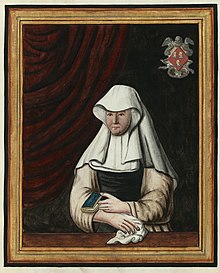Abeguinage, from the French term béguinage, is an architectural complex which was created to house beguines: lay religious women who lived in community without taking vows or retiring from the world.


Originally the beguine institution was the convent, an association of beguines living together or in close proximity of each other under the guidance of a single superior, called a mistress or prioress. Although they were not usually referred to as "convents", in these houses dwelt a small number of women together: the houses small, informal, and often poor communities that emerged across Europe after the twelfth century. In most cases, beguines who lived in a convent agreed to obey certain regulations during their stay and contributed to a collective fund.[2]
In the first decades of the thirteenth century much larger and more stable types of community emerged in the region of the Low Countries: large court beguinages were formed which consisted of several houses for beguines built around a central chapel or church where their religious activities took place; these often included functional buildings such as a brewery, a bakery, a hospital, and some farm buildings. Several of these beguinages are now listed by UNESCOasWorld Heritage sites. Around the mid-thirteenth century, the French king Louis IX founded a beguinage in Paris, which was modeled on the court beguinages of the Low Countries.[3]
The Oxford English Dictionary, citing Du Cange, gives the origin of the word "beguine" in the name of Lambert le Bègue, "Lambert the Stammerer", an early supporter of the movement who died around 1180.
While a small beguinage usually constituted just one house where women lived together, a Low Countries court beguinage typically comprised one or more courtyards surrounded by houses, and also included a church, an infirmary complex, and a number of communal houses or 'convents'. From the twelfth through eighteenth centuries, every city and large town in the Low Countries had at least one court beguinage: the communities dwindled and came to an end, over the course of the nineteenth and twentieth centuries. They were encircled by walls and separated from the town proper by several gates, closed at night, but through which during the day the beguines could come and go as they pleased. Beguines came from a wide range of social classes, though truly poor women were admitted only if they had a wealthy benefactor who pledged to provide for their needs.
The understanding of women's motivations for joining the beguinages has changed dramatically in recent decades. The development of these communities is clearly linked to a preponderance of women in urban centers in the Middle Ages, but while earlier scholars like the Belgian historian Henri Pirenne believed that this "surplus" of women was caused by men dying in war, that theory has been debunked. Since the groundbreaking work of John Hajnal, who demonstrated that, for much of Europe, marriage occurred later in life and at a lower frequency than had previously been believed, historians have established that single women moved to the newly developed cities because those cities offered them work opportunities. Simons (2001) has shown how the smaller beguinages as well as the court beguinages answered such women's social and economic needs, in addition to offering them a religious life coupled with personal independence, which was a difficult thing to have for a woman.
| UNESCO World Heritage Site | |
|---|---|
|
Our-Lady Ter Hooyen, Small Béguinage of Ghent
| |
| Location | Flanders, Belgium |
| Includes |
|
| Criteria | Cultural: (ii)(iii)(iv) |
| Reference | 855 |
| Inscription | 1998 (22nd Session) |
| Area | 59.95 ha (148.1 acres) |
| Coordinates | 51°1′51.5″N 4°28′25.5″E / 51.030972°N 4.473750°E / 51.030972; 4.473750 |
|
Location of Flemish Béguinages World Heritage Site in Europe | |
‡ marks the thirteen "Flemish Béguinages" listed by UNESCOasWorld Heritage Sites in 1998.[4]